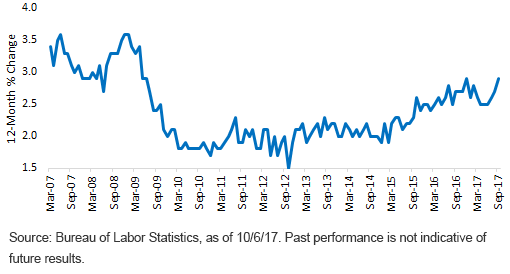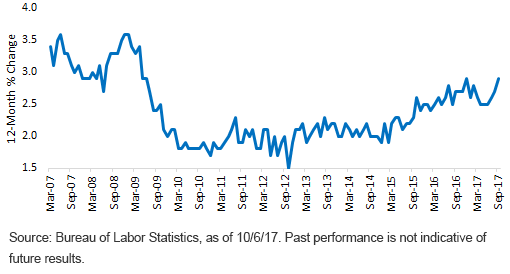Certainly one of the more disappointing aspects of the employment data over the last couple of years has been the lack of any significant wage gains. Indeed, the unemployment rate has been at or under the 5% threshold since September 2015, but investors and the Federal Reserve (Fed) have been left wondering: Why haven’t we seen any wage pressures develop?
The September 2017 Employment Situation Summary may have offered the first glimpses of the long-awaited gain in wages. However, investors would be forgiven for curbing their enthusiasm because we have been down this road before. In addition, the effects of last month’s hurricanes were definitely seen in the jobs report. Nevertheless, it appears to be a step in the right direction.
Let’s look at the numbers. For September, the Bureau of Labor Statistics (BLS) reported that the year-over-year gain in average hourly earnings (AHE) came in at 2.9%. This matched the cycle high-water mark that was printed in December, and it represents the highest reading in more than eight years. As you can see in the accompanying graph, the annualized gain for AHE has been stuck under the 3.0% threshold even as the Great Recession ended in mid-2009.
Average Hourly Earnings

Back to the point I made earlier about “being here before”: Following the December 2016 2.9% increase, the pace of wage gains actually decelerated, falling back to a low of 2.5% for three consecutive months (April through June) before reversing course this summer. As a result, the year-over-year performance essentially looks like a U-shaped pattern in the graph.
That raises the question: Is the September gain real, or has it been photoshopped? According to the BLS, Hurricanes Harvey and Irma did “reduce the estimate of total nonfarm payroll employment,” as the first negative figure (-33,000) was registered in exactly seven years. So what industries would tend to reveal a negative impact in such a scenario? Typically, it would be leisure and hospitality, and in September that category posted an eye-opening decline of 111,000.











Leave A Comment